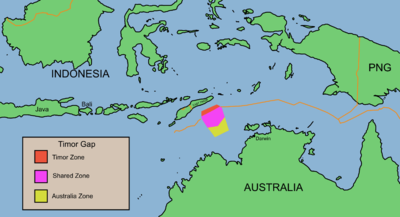Timor Gap Treaty
The Timor Gap Treaty ( German Treaty on the Timor Gap ) was a treaty between Australia and Indonesia on the rights of use of a sea area in the Timor Sea , the so-called Timor Gap .
history
In 1963 the Australian company Woodside Petroleum received permission from Australia to search for oil in the Timor Sea. With Portugal , however, Australia could not agree on the border to the colony of Portuguese Timor . Australia demanded a border drawing along the end of the Australian continental shelf , Portugal demanded an orientation along the center line between the coasts of Timor and Australia.
In 1972, Australia agreed with Indonesia to draw a corresponding border between the two states in the Timor Sea, so that Australia's maritime border to the north only had a gap ( English gap ) with Portuguese Timor, the so-called "Timor Gap". 1975 came in the wake of decolonization of East Timor to civil war between the parties of the country. The Portuguese colonial administration withdrew and Indonesia began to occupy the border regions. When FRETILIN, which had emerged victorious from the civil war, unilaterally proclaimed independence on November 28, 1975, Indonesia invaded the rest of the country on December 7, with the backing of Australia, and annexed East Timor in 1976 as its 27th province. This was not recognized internationally. Officially, the area was considered "Portuguese territory under Indonesian administration".
On December 11, 1989, the Timor Gap Treaty between the governments of Indonesia and Australia was concluded on the division of rights of use; it came into force on February 9, 1991. In order to avoid disputes about the sea border, the question was simply left out. Instead, three zones of cooperation were created in which both countries wanted to jointly produce oil. In Zone A (on the map in pink) 50% of the tax profits should go to the partners, in Zone B (on the map yellow) Indonesia should receive 10% of the taxes collected from Australia and in Zone C (on the map red ) Australia 10% of Indonesia's taxes. Portugal sued Australia in the International Court of Justice over the Timor Gap Treaty , but the court was unable to hear it because Indonesia refused to attend.
With the withdrawal of the Indonesian occupiers and the independence of East Timor on May 20, 2002, usage and property rights were again the subject of new negotiations.
Web links
Individual evidence
- ↑ Kim McGrath: Oil, gas and spy games in the Timor Sea , the Monthly, April 2014 , accessed May 1, 2014.
- ↑ a b The View from LL2: Google Earth Map for the Timor Sea Maritime Boundary Dispute , March 17, 2014
- ^ ANTS - Agreements, Treaties and negiotiated settlements project: TIMOR GAP TREATY between Australia and the Republic of Indonesia on the Zone of cooperation in an area between the Indonesian Province of East Timor and Northern Australia
- ^ Government of Timor-Leste: Australia changes position on maritime boundaries , June 5, 2014 , accessed July 1, 2014.
